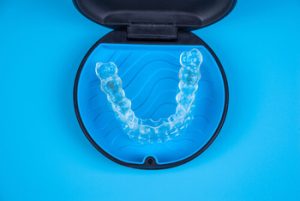In cosmetic dentistry, individuals seeking a perfect smile often choose between two popular options: Invisalign and veneers. Both treatments offer transformative results but cater to different dental needs and preferences.
This comprehensive exploration of invisalign vs veneers will delve into the nature of both treatments, specifically highlighting the advantages of veneers over Invisalign, to assist you in making an informed decision about which option best suits your needs.
When considering cosmetic treatment to enhance one’s smile, it is crucial to understand the options available and how they align with your dental health goals. This blog will provide an in-depth comparison of Invisalign and veneers, focusing on the benefits of veneers and helping you to navigate the decision-making process confidently.
What Are Veneers?
Definition and Purpose
Veneers are precisely crafted from durable materials to fit over the front of your teeth. They improve dental aesthetics by addressing imperfections such as discolouration, uneven teeth, chips, and cracks. By covering the existing tooth, veneers can create a new, visually appealing front surface.
Types of Veneers
There are mainly two types of veneers: porcelain and composite resin. Each type has unique attributes and is chosen based on the patient’s needs, budget, and desired outcome.
Porcelain Veneers
Porcelain veneers are the most popular type due to their strength, durability, and natural appearance. They are made from high-quality ceramic materials that mimic the light-reflecting properties of natural teeth and resist stains better than other types of veneers. Porcelain veneers are custom-made in a dental laboratory, making them a long-lasting and aesthetically pleasing option.
Composite Resin Veneers
Composite veneers, on the other hand, are made from tooth-coloured resin that can be shaped and bonded to teeth in a single visit.
While composite veneers are less expensive than porcelain veneers, they are not as durable or stain-resistant. However, they can be a cost-effective solution for patients looking for a less permanent option that still offers significant cosmetic improvement.
What is Invisalign?
Invisalign is an orthodontic treatment that uses clear aligners to gradually straighten teeth. Unlike traditional metal braces, Invisalign aligners are virtually invisible and can be removed for eating, drinking, and oral hygiene. This method is highly popular among adults and teens who seek a less noticeable form of orthodontic treatment.
Advantages of Getting Veneers Over Invisalign
When comparing the merits of Invisalign and dental veneers, it’s essential to look beyond the surface and examine how each treatment aligns with specific dental conditions and aesthetic desires. Whether made from porcelain or composite resin, veneers provide a versatile and robust solution to various dental issues. Here, we’ll delve deeply into why veneers can be preferable over Invisalign, particularly for those looking for immediate and impactful cosmetic enhancements.
Rapid Transformation
One of the most significant advantages of veneers—particularly porcelain veneers—over Invisalign is the immediacy of results. Dental veneers are designed to cover the teeth’ front surface, instantly altering your smile’s appearance. In contrast, Invisalign involves gradually moving teeth slowly through clear aligners. The treatment process with Invisalign can take 6 to 24 months, depending on the severity of tooth misalignment.
Veneers are an excellent choice for individuals with discoloured teeth, chips, or slight misalignment who desire quick results. They allow for the correction of multiple issues simultaneously, such as teeth’s shape, size, and colour, making them an integral part of cosmetic dental treatments.
Customisation and Aesthetics
Porcelain veneers are crafted from a mould of your teeth, ensuring they fit perfectly and meet your specific aesthetic goals. The ability to match the colour of porcelain veneers to existing teeth makes them highly attractive for achieving a natural-looking smile. This level of customisation is unmatched by Invisalign, which primarily focuses on alignment and can sometimes reveal the stained or eroded teeth underneath once the teeth are straightened.
Moreover, veneers can be used to create a uniform look, treating teeth that are uneven or have gaps—issues that might not be fully correctable with Invisalign alone. Veneers offers a cosmetic treatment that is both transformative and bespoke, allowing for a tailored smile that enhances your overall facial aesthetics.
Durability and Protection
Porcelain veneers are aesthetically pleasing and provide a durable solution to dental issues. With proper care, veneers can last more than a decade, whereas Invisalign’s clear aligners are temporary and serve no purpose once the treatment is completed. Furthermore, veneers protect the surface of your teeth from further damage, such as tooth decay and wear from grinding, which can be an advantage over the orthodontic treatment offered by Invisalign.
Stain Resistance
For patients concerned with oral health and the appearance of their smile, porcelain veneers offer an excellent benefit in terms of stain resistance. Unlike natural teeth, which can stain and require periodic whitening treatments, porcelain veneers maintain their colour and brightness for years. This makes veneers a superior option for those looking to achieve and maintain a brighter smile without the constant need for whitening procedures.
Minimal Intrusion
Getting veneers typically requires only a few visits to the dentist and does not significantly alter your daily life. In contrast, Invisalign treatment requires frequent visits for aligner adjustments and can be intrusive to daily routines, as the aligners need to be removed and cleaned regularly. Once placed, veneers need only the same care as your natural teeth—regular brushing, flossing, and occasional professional cleanings.
Orthodontic Limitations
Comprehensive Smile Makeover
Veneers can be part of a comprehensive treatment plan that addresses several aesthetic issues simultaneously. They are often combined with other dental procedures to create a complete smile makeover—something Invisalign alone might not achieve. Whether replacing eroded tooth enamel, correcting a misshapen tooth, or filling gaps between teeth, veneers can be used strategically to enhance the overall appearance of your smile in ways that orthodontic treatment cannot match.
Ideal Candidates for Veneers
When considering cosmetic dental treatments, understanding who stands to benefit most from veneers is crucial. Veneers, particularly porcelain veneers, are an excellent option for individuals seeking to enhance the appearance of their smile. This section will explore the characteristics of ideal candidates for veneers, focusing on various aspects that determine suitability, such as dental health, aesthetic goals, and lifestyle factors.
Individuals with Cosmetic Dental Concerns
Veneers are particularly suited for individuals seeking to address various cosmetic dental issues. If you have teeth that are discoloured, chipped, cracked, or slightly misaligned, veneers provide an effective and immediate solution. They are custom-designed to cover the front surface of your teeth, enhancing or completely transforming your smile’s appearance.
Discoloured Teeth
For those with severe discolouration that traditional teeth whitening cannot correct—such as stains caused by medications, excessive fluoride, or other intrinsic stains—veneers offer permanent whiteness and brightness that can be matched to the desired shade.
Chipped or Cracked Teeth
Veneers are an excellent option for repairing and covering up chips and cracks in teeth. They restore the teeth’s aesthetic appearance and provide a protective layer that helps prevent future damage.
Slightly Misaligned or Gapped Teeth
Veneers can be an attractive alternative to braces or clear aligners for patients with minor alignment issues or gaps between their teeth. They can be crafted to change the shape and size of the teeth, creating an appearance of straight teeth without the need for orthodontic treatment.
Those Seeking a Long-Lasting Solution
Veneers are a durable cosmetic solution designed to last for many years. They are made from high-quality materials like porcelain, which is resistant to wear and staining. Veneers can be an excellent choice for individuals looking for a long-term investment in their smile. Regular maintenance and good oral hygiene can extend the life of veneers significantly, making them a worthwhile consideration for those committed to maintaining their oral health.
Individuals with Good Oral Hygiene
Maintaining good oral hygiene is crucial for candidates considering veneers. Since veneers are applied to the existing tooth structure, the health of your natural teeth and gums plays a significant role in the success and longevity of the treatment. Candidates should be committed to a rigorous oral hygiene regimen, including regular brushing, flossing, and dental check-ups. This not only supports the veneers’ health but also the mouth’s overall health.
People Looking for a Quick Cosmetic Enhancement
Unlike orthodontic treatments that can take years to see complete results, veneers provide an immediate transformation. This makes them ideal for individuals who desire a quick improvement in their smile, such as for upcoming significant events like weddings, graduations, or professional engagements. Veneers allow for a dramatic change in a short amount of time, providing straight teeth and a flawless smile quickly and efficiently.
Patients with Teeth That Gradually Shift
For those who have experienced a gradual shifting of their teeth over time, whether due to genetics, ageing, or previous orthodontic treatments, veneers can offer a renewed and lasting solution. They help maintain an aesthetically pleasing alignment and can prevent further shifting by providing a physical barrier.
Candidates for Replacement Veneers
Individuals who already have veneers but are looking to replace them due to wear and tear or aesthetic preferences can also consider getting new veneers. Replacement veneers can be crafted to adapt to changes in the dental structure or updated cosmetic desires, ensuring that your smile continues to look its best.
Veneers Procedure
The procedure for applying veneers is meticulous and requires precise planning and skilled execution. It involves several key steps designed to ensure that the final result meets and exceeds the patient’s expectations. This detailed guide will walk you through each stage of the veneer procedure, providing a clear understanding of what to expect and how best to prepare.
Initial Consultation and Evaluation
The first step in the veneer procedure is an initial consultation with a dental professional. This session is crucial as it allows the dentist to assess your oral health, discuss your aesthetic goals, and determine if veneers are the most suitable option for you.
Discussing Expectations
During this consultation, you will have the opportunity to express what you hope to achieve with the entire treatment process. Whether you want to correct discoloured teeth, close gaps, or make teeth appear straighter, your dentist will consider your desires while evaluating the health and structure of your existing teeth.
Oral Health Assessment
A thorough examination will ensure your teeth and gums are healthy enough to support veneers. This involves checking for signs of tooth decay, gum disease, and other potential issues that could affect the veneers’ longevity and appearance.
Treatment Planning
The dentist will create a detailed treatment plan once you are deemed a suitable candidate for veneers. This plan outlines the specific changes that will be made to the tooth surface, the type and number of veneers required, and the steps involved in the application process.
Tooth Surface Analysis
A critical part of the planning process involves analysing the tooth surface to which the veneers will be bonded. The dentist assesses the enamel quality and the overall alignment of your teeth to determine how best to proceed with the veneers without compromising your oral health.
Tooth Preparation
Preparing the teeth for veneers typically involves reshaping the existing tooth structure. This is necessary to provide a suitable surface for the veneers to adhere to and to ensure that the veneers fit in naturally with the surrounding teeth.
Enamel Removal
A minimal amount of enamel from the tooth surface is removed to make room for the veneers. This process is carefully done to preserve as much of the natural tooth structure as possible while providing a strong adhesive surface for the veneers.
Temporary Veneers
In most cases, temporary veneers are placed after the teeth have been prepared. These serve as a protective cover for the prepared teeth and give you a preview of your new smile. This phase is crucial for ensuring the veneers’ fit and colour are perfect before the final application.
Custom Veneer Creation
After your teeth are prepared, detailed impressions of your teeth are taken and sent to a dental laboratory where your custom veneers are crafted. This step is vital as it ensures that your veneers will perfectly fit in size, shape, colour, and clarity.
Lab Collaboration
Dentists work closely with dental laboratories, providing detailed instructions and expectations. This collaboration is essential to create veneers that meet the patient’s precise cosmetic and functional needs.
Final Fitting and Bonding
Once the veneers are ready, a final fitting is conducted. During this appointment, the dentist places the veneers on your teeth to check their fit and appearance. Any minor adjustments are needed to ensure the veneers meet your expectations and feel comfortable.
Bonding Process
The final step involves permanently bonding the veneers to the tooth surface. A adhesive is applied, and a light-sensitive resin is placed between the veneer and tooth. A curing light is then used to harden this resin quickly, securely attaching the veneer to the tooth.
Post-Procedure Care and Follow-up
After placing the veneers, you will be advised how to care for them. Good oral hygiene, avoiding hard foods, and regular dental visits are crucial to maintaining the veneers and ensuring longevity.
Regular Check-ups
Regular check-ups are important to monitor the veneers and address any issues early. These visits allow the dentist to inspect the veneers for any signs of wear or detachment and to make any necessary adjustments.
Conclusion
Choosing between Invisalign and veneers depends on your specific dental needs, natural teeth condition, and long-term cosmetic goals. If you seek rapid, long-lasting cosmetic improvement, veneers might be suitable. However, Invisalign offers a discreet and effective solution for those looking to correct the alignment of their teeth gradually.
If you’re considering veneers or Invisalign and want to explore which option best suits your situation, we invite you to contact Casey Dentists. Our team of dedicated professionals is ready to help you achieve the smile you’ve always wanted. Call us today at 07 4801 7035 for a consultation and start your journey towards a more confident, beautiful smile.
References
https://www.healthdirect.gov.au/veneers
https://www.colgate.com/en-in/oral-health/veneers/what-are-veneers-and-how-should-you-care-for-them



